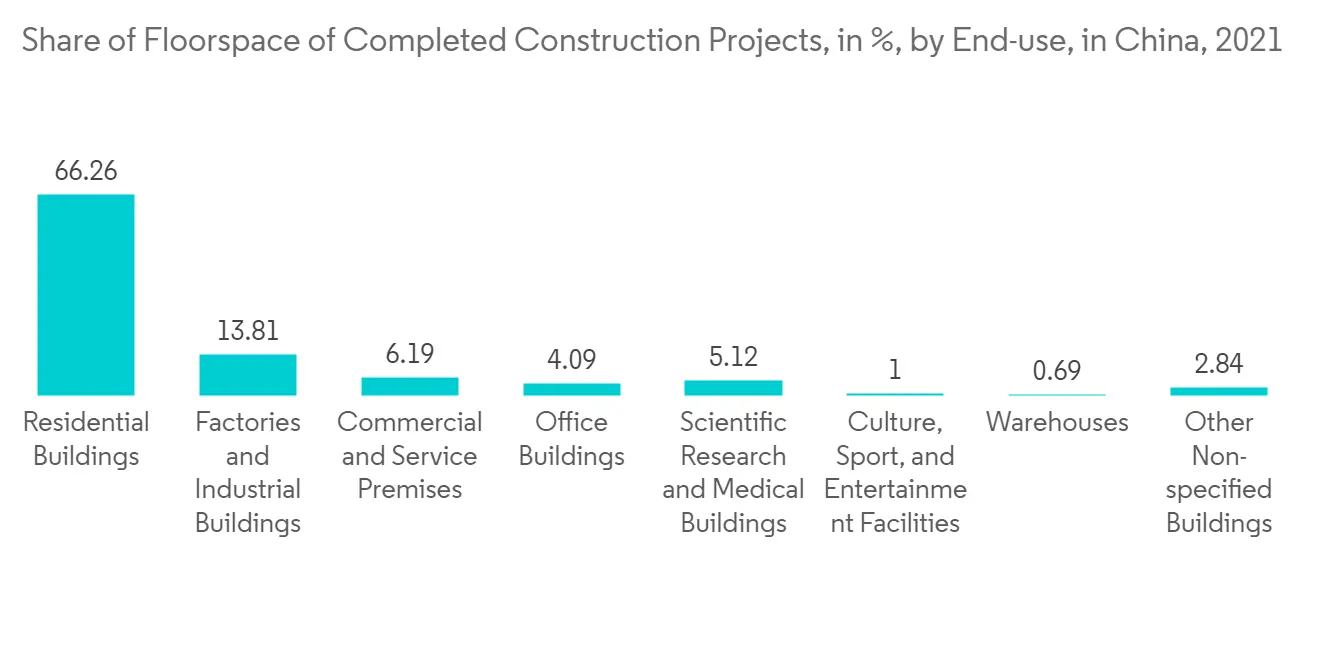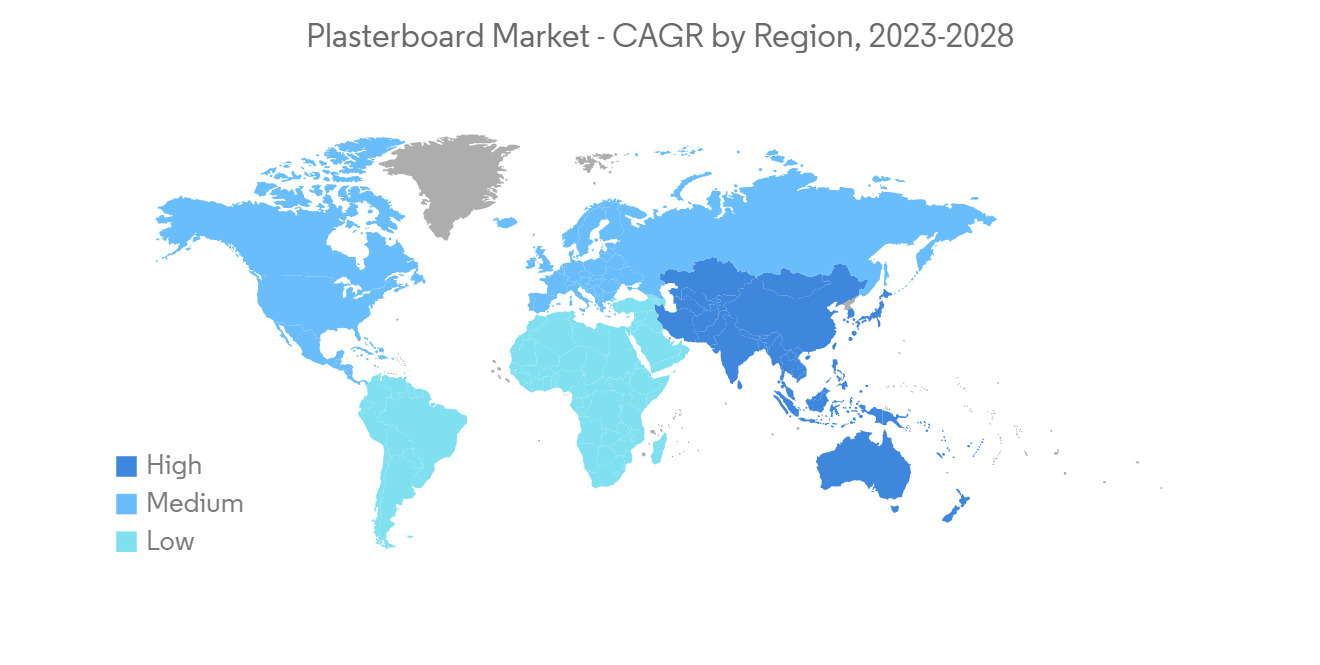PUBLISHER: Mordor Intelligence | PRODUCT CODE: 1273432

PUBLISHER: Mordor Intelligence | PRODUCT CODE: 1273432
Plasterboard Market - Growth, Trends, and Forecasts (2023 - 2028)
During the time frame of the forecast, the global plasterboard market is expected to grow at a CAGR of more than 5%.
The outbreak of COVID-19 impacted plasterboard market growth in 2020 due to slowed construction industry growth. Because the income of a relatively large part of society was affected, it had a negative effect on the liquidity of money, which in turn had a negative effect on the performance of the construction sector. Also, problems with getting raw materials and workers were some of the biggest things that slowed down construction in 2020.But the increase in building projects after the pandemic has made more people want plasterboard.
Key Highlights
- Most of the growth in the plasterboard industry can be attributed to the rise in residential construction and the need for more fire-resistant building materials.
- Lack of awareness among residential end-users and a lack of places to get rid of waste plasterboard are likely to slow the growth of the market.
- In the future, it is expected that new lightweight plasterboards will give the market a chance to grow.
- Asia-Pacific was the biggest market for plasterboard because the building industry in developing countries like China, India, and Indonesia was growing so quickly.
Plasterboard Market Trends
Increasing Demand from Residential Construction
- The number of people in the middle class is growing, and their disposable income is also going up. This has helped the middle-class housing market grow, which will increase the use of plasterboard over the next few years.
- Even though there is more demand, there is still a big shortage of housing around the world.This gives investors and developers a big chance to use different ways of building and make new partnerships to move development forward.
- The Asia-Pacific region is expected to have the most growth because the housing construction market in China and India is growing. China, India, and Southeast Asian nations are in charge of the largest low-cost housing construction segment in Asia-Pacific.
- In 2021, the floor space of new residential real estate construction will amount to around 1.46 trillion square meters in China. Residential buildings accounted for the largest share of completed construction in China in 2021. Almost 67 percent of the completed floor space belonged to buildings designated for housing.
- Furthermore, in the United States, privately owned single-family housing that had finished construction had more than 1 million units in January 2021, as compared to 942 thousand units in January 2020. Moreover, privately owned housing units authorized by building permits were at a seasonally adjusted annual rate of 1.33 million units in December 2022. This is 1.6 percent below the revised November rate of 1.35 million units and 29.9 percent below the December 2021 rate of 1.9 million units.
- In India, the government initiated a project called "Housing for All by 2022," which is expected to immensely drive the low-cost residential construction segment in the country throughout the forecast period.
- Due to the increasing middle-class population and residential building construction, coupled with government initiatives and investments, the demand for plasterboard in the residential sector across all regions is expected to increase during the forecast period.

The Asia-Pacific Region to Dominate the Market
- In Asia-Pacific, China is the largest economy in terms of GDP. The growth rate in the country remains high, but it is gradually diminishing as the population is aging and the economy is rebalancing from investment to consumption, manufacturing to services, and external to internal demand.
- China's construction industry grew quickly because the government pushed for investments in infrastructure to keep the economy growing. The value of new contracts signed by Chinese construction companies in 2021 was approximately CNY 34.5 trillion (USD 0.48 trillion), which is more than half of the total.
- Even though the growth of the real estate market is unpredictable, the Chinese government has put a lot of effort into building rail and road infrastructure to keep up with the growing industrial and service sectors. This has led to a lot of growth in the Chinese construction industry in recent years.Since most construction companies are owned by the government, the increase in government spending is helping the construction business in the country.
- China is becoming more and more urban, and by 2050, 255 million more people are expected to live in cities. started by the government to help migrants find social housing and to expand urban facilities in big cities.The government has also said it will spend more than USD 162 billion to fix up "shantytowns" in cities.
- India is likely to witness an investment of around USD 1.3 trillion in housing over the next few years, during which the country is likely to witness the construction of 60 million new homes. By 2024, the number of affordable homes in India is expected to have grown by about 70%.In June 2022, FDI in the construction and development of townships, housing, built-up infrastructure, and infrastructure development projects stood at USD 28.64 billion.
- Overall, the market that was looked at is expected to grow at high rates. This is because the construction industry in the country and region is growing quickly.

Plasterboard Industry Overview
There are only a few big players in the global plasterboard market. The top five players make up a big chunk of the market. Key players in the plasterboard market include Etex Group, National Gypsum Services Company, Saint-Gobain, Georgia-Pacific, and AWI Licensing LLC, among others (not in any particular order).
Additional Benefits:
- The market estimate (ME) sheet in Excel format
- 3 months of analyst support
TABLE OF CONTENTS
1 INTRODUCTION
- 1.1 Study Assumptions
- 1.2 Scope of the Study
2 RESEARCH METHODOLOGY
3 EXECUTIVE SUMMARY
4 MARKET DYNAMICS
- 4.1 Drivers
- 4.1.1 Strong Demand for Dry Construction Methods over Wet Methods
- 4.1.2 Increasing Demand from Residential Construction
- 4.1.3 Rising Demand for Fire-resistant Construction Materials
- 4.2 Restraints
- 4.2.1 Lack of Awareness
- 4.2.2 Lack of Availability of Plasterboard Waste Disposal Plants
- 4.3 Industry Value Chain Analysis
- 4.4 Porter's Five Forces Analysis
- 4.4.1 Bargaining Power of Suppliers
- 4.4.2 Bargaining Power of Consumers
- 4.4.3 Threat of New Entrants
- 4.4.4 Threat of Substitute Products and Services
- 4.4.5 Degree of Competition
5 MARKET SEGMENTATION (Market Size in Volume)
- 5.1 Form
- 5.1.1 Square-edge
- 5.1.2 Tapered
- 5.2 Type
- 5.2.1 Damp-roof Plasterboard
- 5.2.2 Fire-resistant Plasterboard
- 5.2.3 Impact-resistant Plasterboard
- 5.2.4 Insulated Plasterboard
- 5.2.5 Moisture-resistant Plasterboard
- 5.2.6 Sound-resistant Plasterboard
- 5.2.7 Standard Plasterboard
- 5.2.8 Thermal Plasterboard
- 5.3 End-use Sector
- 5.3.1 Residential
- 5.3.2 Non-residential
- 5.4 Geography
- 5.4.1 Asia-Pacific
- 5.4.1.1 China
- 5.4.1.2 India
- 5.4.1.3 Japan
- 5.4.1.4 South Korea
- 5.4.1.5 ASEAN Countries
- 5.4.1.6 Rest of Asia-Pacific
- 5.4.2 North America
- 5.4.2.1 United States
- 5.4.2.2 Canada
- 5.4.2.3 Mexico
- 5.4.3 Europe
- 5.4.3.1 Germany
- 5.4.3.2 United Kingdom
- 5.4.3.3 Italy
- 5.4.3.4 France
- 5.4.3.5 NORDIC Countries
- 5.4.3.6 Rest of Europe
- 5.4.4 South America
- 5.4.4.1 Brazil
- 5.4.4.2 Argentina
- 5.4.4.3 Rest of South America
- 5.4.5 Middle-East and Africa
- 5.4.5.1 Saudi Arabia
- 5.4.5.2 South Africa
- 5.4.5.3 Rest of Middle-East and Africa
- 5.4.1 Asia-Pacific
6 COMPETITIVE LANDSCAPE
- 6.1 Mergers and Acquisitions, Joint Ventures, Collaborations, and Agreements
- 6.2 Market Share (%)**/Ranking Analysis
- 6.3 Strategies Adopted by Leading Players
- 6.4 Company Profiles
- 6.4.1 AWI Licensing LLC
- 6.4.2 Ahmed Yousuf & Hassan Abdullah Co. (AYHACO GROUP)
- 6.4.3 ATISKAN STRUCTURE AND INDUSTRIAL GYPSUM PRODUCTS INDUSTRY. VE TIC. Inc.
- 6.4.4 Etex Group
- 6.4.5 Fletcher Building
- 6.4.6 Georgia-Pacific
- 6.4.7 Gyprock
- 6.4.8 Gypsemna
- 6.4.9 Gyptec Iberica
- 6.4.10 Jason Plasterboard Co. Ltd.
- 6.4.11 LafargeHolcim
- 6.4.12 Mada Gypsum
- 6.4.13 National Gypsum Services Company
- 6.4.14 ECPlaza Network Inc.
- 6.4.15 Saint-Gobain
- 6.4.16 USG Boral
- 6.4.17 CERTAINTEED
- 6.4.18 JN Linrose
- 6.4.19 American Gypsum
7 MARKET OPPORTUNITIES AND FUTURE TRENDS
- 7.1 Emerging Lightweight Plasterboards
- 7.2 Other Opportunities




